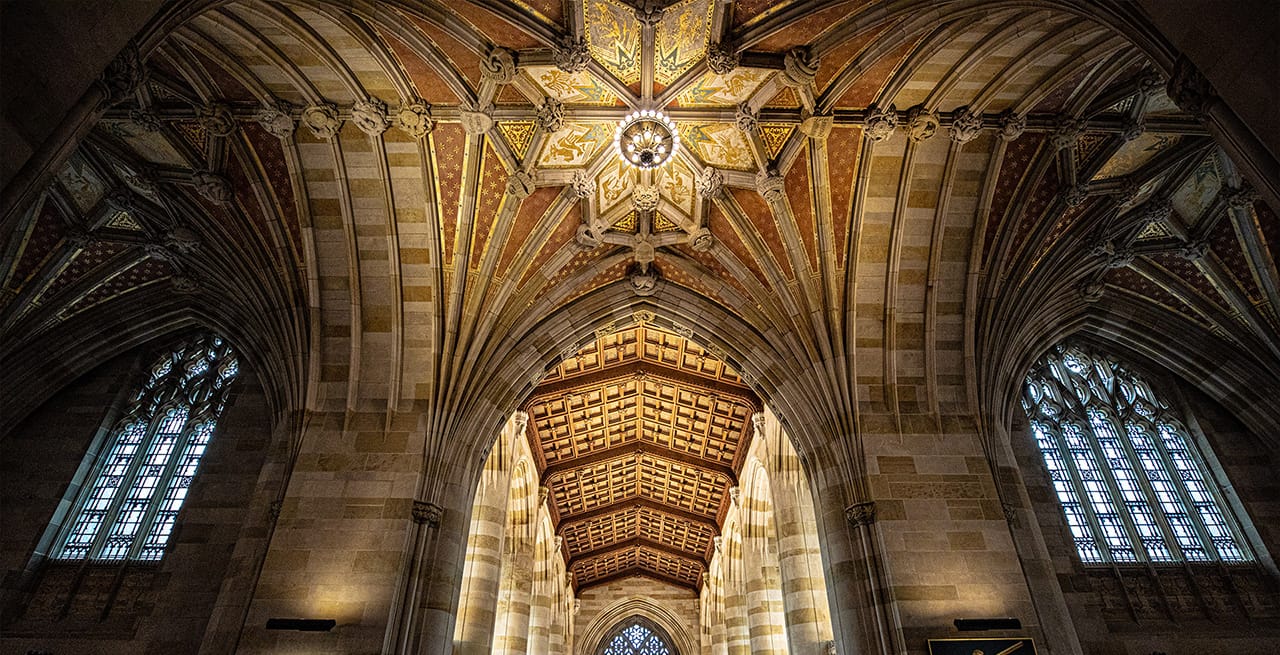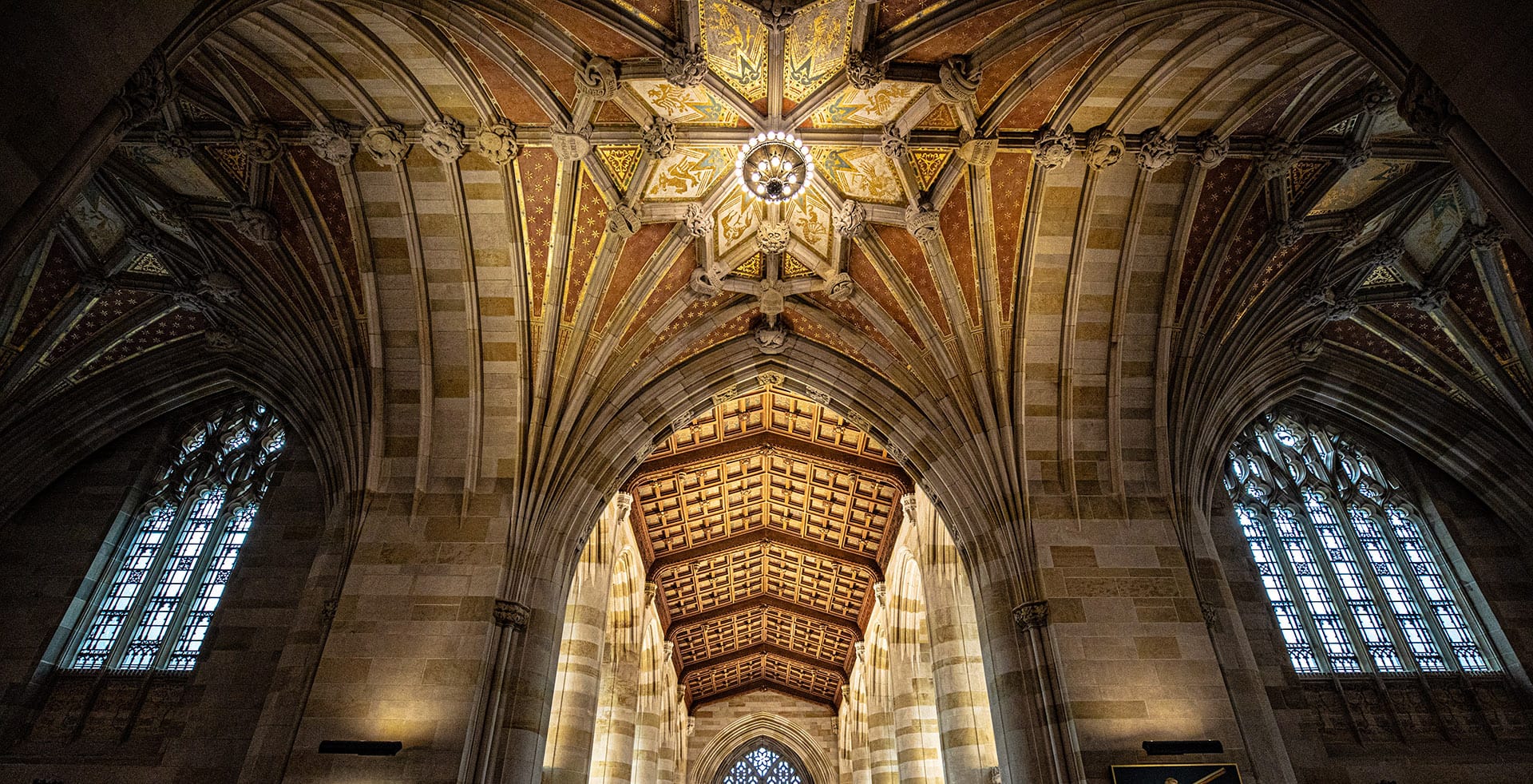Commencement 1702–2022
The first Commencement of the Collegiate School was held on September 16, 1702, in Saybrook, Connecticut, in the house of the Reverend Thomas Buckingham, one of the founders of the institution. The Reverend James Pierpont, minister of the First Church of Christ in New Haven (Center Church), was one of the leaders in founding the school and served as a fellow from 1701 to 1714. The first Commencement in New Haven, with a graduating class of five, was held at Center Church in 1717.
On September 10, 1718, at the first public ceremony of Commencement, the institution was named Yale College in honor of its first benefactor, the Honorable Elihu Yale, of Wrexham, Wales. The name Yale University was authorized in 1887.
Except for private ceremonies during the American Revolution, Yale Commencement exercises were conducted in the church until 1895, when they were transferred to Battell Chapel. In 1903, Commencement was held for the first time in Woolsey Hall; it continued there until 1950, when the postwar increase in the size of graduating classes necessitated a move to the present location on Old Campus.
Assembly and Procession
The academic procession is under the direction of members of the faculty and administration appointed annually to serve as marshals. Degree candidates in Yale College assemble in the courtyards of their residential colleges and march, behind their individual college banners, to Cross Campus, where they join the candidates for graduate and professional degrees to await the formation of the procession. The senior marshal and chief procession marshal, the colors, the president’s banners, and the band leave from the Noah Porter Gateway and proceed down Elm Street to the New Haven green, followed by the Yale College candidates. Upon entering the green, the files of candidates separate, move to the edges of the walk leading around Center Church, and continue until they reach College Street opposite Phelps Archway. They then stand facing the walk to await the party of the Yale Corporation, the university’s board of trustees (university banner, chief marshal, university officers, Corporation members, and honorary degree recipients), which passes through the groups of candidates for graduate and professional degrees who are assembled on Cross Campus, and proceeds down Elm Street followed by the banners and deans of Yale College and the Faculty of Arts and Sciences. When the Corporation and Yale College parties reach the green, they pass between the files of seniors, who thereafter follow in procession through Phelps Archway and down the center aisle of Old Campus.
In the meantime, after the Corporation party has passed through Cross Campus, the candidates for graduate and professional degrees proceed through the Noah Porter Gateway to Elm Street and enter Old Campus through Miller Gate and the High Street Gate under the direction of their faculty marshals.
The national, state, and city flags; the university, Yale College, and president’s banners; and the banners of the residential colleges, the Graduate School of Arts and Sciences, the Faculty of Arts and Sciences, and the professional schools are led by the senior marshal in procession to the platform.
Academic Costume
Academic gowns represent a tradition handed down from the universities of the Middle Ages. These institutions were founded by the church, and the students, being clerics, were obliged to wear the prescribed gowns at all times. Round caps later became square mortarboards; the hoods, originally cowls attached to the gowns, could be slipped over the head for warmth.
Many European universities have distinctive caps and gowns that differ from those commonly worn in this country. Some of the gowns are of bright colors, and some are embellished with fur. The usual color for academic gowns in the United States is black. Those holding Yale master’s and doctoral degrees, however, may wear Yale blue. The bachelor’s gown is worn closed; the master’s and doctor’s may be worn open or closed. The shape of the sleeve is the distinguishing mark of the gowns: bachelor’s, long pointed sleeves; master’s, oblong sleeves open at the wrist; doctor’s, bell-shaped with three velvet bars on each sleeve. Yale candidates for professional degrees requiring at least three years of graduate study, such as the J.D. or M.Div., are permitted to wear the doctor’s gown.
Caps are black, as are the tassels for B.A. and B.S. degrees; tassels for the Ph.D. degrees are gold, and those for other graduate and professional degrees may be the color corresponding to the border of the hoods.
The hoods are lined with the color of the institution that awarded the degree to the wearer. The color of the border or collar of the hood designates the degree: liberal arts, white; science, golden yellow; philosophy, dark blue; architecture, blue-violet; art and drama, brown; divinity, scarlet; engineering, orange; environment, russet; law, purple; management, sapphire blue; medicine, green; music, pink; nursing, apricot; public health, salmon.
Honorary degree hoods are distinguished as follows: doctor of divinity (D.D.), scarlet; doctor of laws (LL.D.), purple; doctor of music (Mus.D.), pink; doctor of letters (Litt.D.), white; doctor of science (Sc.D.), golden yellow; doctor of humane letters (L.H.D.), white; doctor of fine arts (D.F.A. Hon.), brown; doctor of social science (S.Sc.D.), cream; doctor of medical sciences (D.M.S.), green; doctor of humanities (D.Hum.), white; doctor of engineering and technology (D.Eng. & Tech.), orange.
University Insignia
The university mace, emblem of the authority of the president and trustees, is carried by the chief marshal. It was given to the university by Professor Samuel Simons Sanford, M.A.H. 1894, and has been used in academic processions since 1904. The mace, made of silver gilt, weighs twenty-four pounds and is forty-seven inches long. At the foot of the shaft is an acorn, out of which come oak leaves, the symbol of strength. These leaves surround a sphere on which appear the seal and name of the donor. On the shaft are engraved the names of all the presidents of the university. Above the main shaft is a spherical section with a design of raised elm leaves surmounted by a cup that bears the arms of the university, of New Haven, of Connecticut, and of the United States. On the rim of the cup are four winged figures representing art, science, law, and theology. Rising above these figures is a deep blue sphere of lapis lazuli topped by a small pinecone, ancient symbol of immortality.
The president’s collar is of gold, silver, and enamel. There are eleven cloisonné and champlevé roundels bearing the arms of the graduate school and the professional schools and three shields bearing the arms of the university and Yale College and the Great Seal of the United States. From the collar is suspended a jewel composed of a pair of carved and polished glass medallions, back to back, between which floats a gold fragment embossed with the arms of the university. The gold mountings for the jewel are set with cloisonné enamel plaques, which bear the Hebrew characters ![]() , referring to the sacred lots of the Bible, and the university’s motto, Lux et Veritas, based upon an ancient Latin rendering of the Hebrew.
, referring to the sacred lots of the Bible, and the university’s motto, Lux et Veritas, based upon an ancient Latin rendering of the Hebrew.
The senior marshal of the faculty carries a mace presented to the university in 1948 by Loomis Havemeyer, Ph.B. 1910, Ph.D. 1915. It is believed to be an eighteenth-century Dutch bandmaster’s baton. The shaft is of wood with a richly decorated silver knob.
The chief procession marshal’s mace consists of a wooden shaft surmounted by the head of a “yale”—a fabulous and mythical beast of ancient lineage—made and formerly carried in processions by the late Theodore Sizer, M.A.H. 1931, professor of the history of art and pursuivant of arms to the university.
The Old Campus marshal carries a mace fashioned from a slender staff surmounted by a section of the Old Yale Fence in miniature.
The faculty marshal of each residential college carries a mace especially designated for that college, while the student marshals carry wooden batons. Distinctive maces are also carried by the marshals of the Graduate School of Arts and Sciences, the Faculty of Arts and Sciences, and the professional schools. Each of these areas also has its own heraldic banner. Derived from the arms illustrated on these pages and carried by students, many of these banners were designed by Professor Sizer.
Ceremony and Degrees
During the ceremony, student marshals receive symbolic diplomas for the degrees in course as they are announced. When the benediction has been pronounced, the band begins the recessional. Following the banners, the president and chief marshal lead the Corporation party off the platform. The new graduates are then led from Old Campus.
The first bachelor of arts degree at Yale (then the Collegiate School) was awarded solely on examination to Nathaniel Chauncey (fellow 1746–1752) in 1702. John Hart, B.A. 1703 (tutor 1703–1705), received the first degree in course. The first doctor of philosophy degree awarded in the United States was conferred at Yale in 1861. Other degrees at Yale were first conferred as follows: medicine, 1814; law, 1843; engineering, 1860; divinity, 1867; master of arts in course, 1876; fine arts, 1891; music, 1894; master of science, 1899; environment, 1902; public health, 1920; nursing, 1926; drama, 1931; architecture, 1942; management, 1978. The bachelor of philosophy degree was conferred from 1852 to 1931, and the bachelor of liberal studies from 1984 to 2013. The tradition of awarding honorary degrees at Yale was begun with four master’s degrees in 1702.

